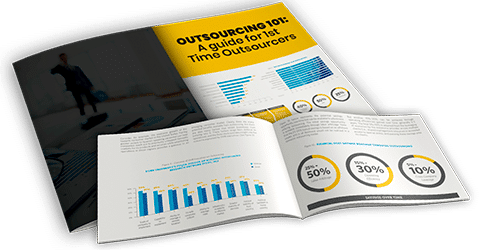Outsourcing is no longer just about cost savings. It’s an undeniably strategic tool that enables companies to capitalize on the world’s evolution into a smaller, more tech-savvy place
Spending on outsourced services has exploded over the past two decades – from $45.6 billion in 2000 to $86.6 billion in 2018 – and there’s no sign of it slowing down. Behind this boom are companies enjoying a competitive edge from process improvements, improved focus on their core business, increased efficiencies, expanded talent pools, reduced time to market, and, of course, cost containment.
There’s no denying that there are also inherent risks in introducing a third-party to perform some of your organization’s business processes. Choosing the wrong partner can lead to degraded quality, slower turnaround times, and unhappy customers and employees. Choosing to outsource just to save money, for example is a surefire way to limit the rewards that you might reap if you were to strategically focus on a long term solution that repeatedly benefits the organization exponentially.
Choose the right outsourcing partner and prepare to reap the rewards of increased efficiency which can subsequently drive higher returns, a reduction in labor costs (which is a given), and a new found focus on the core business, as well as a team that can actually be managed close to home.
If your company is considering outsourcing for the first time – or aims to outsource additional business functions in the future – following these six steps can help maximize opportunities for success with the right outsourcer and shield your business from the mistakes that torpedo other projects and initiatives with the wrong outsourcer.

6 strategies for successful outsourcing
1. Define clear objectives.
The most successful outsourcing strategies start with a clear statement of what your business aims to accomplish and measurable goals versus just trying to “save money.” This is your chance to refocus the organization. The cost-savings? That’s a given. Detail the reasons for your outsourcing program, show the business value, and provide a working framework for making key decisions such as which outsourcing vendor to use, what processes to offload, and what levels of risk to assume. Rushing headlong into a project with just any outsourcing provider without vetting them or without taking the time to clearly define its objectives creates an unfocused strategy, leading to higher costs, wasted resources, and lost business opportunities.
2. Create realistic expectations.
After you’ve established your goals and objectives, consider whether they’re realistic. Are you improving the situation by outsourcing? Or are you merely moving the problem? While you may eventually be able to achieve your lofty goal of saving 40 or 50 percent on labor costs by outsourcing, it’s better to start with more cautious objectives and timing projections that ensure continued support for your strategy.
Unrealistic expectations of enormous immediate savings have toppled many outsourcing ventures. Hidden costs such as increased communications expenses and transitioning business processes may minimize your first-year performance. That doesn’t mean your outsourcing is unsuccessful; executive teams need to understand from the start that outsourcing is a long-term investment with considerable long-term rewards. But let’s be clear why you are outsourcing. This is about driving higher performance for the organization, possibly by automating certain processes. As teams mature and corporate culture adapts to the new business processes, the right outsourcing provider will become a seamless extension of your internal teams and the benefits of a well-managed outsourcing strategy will compound and in most cases, the impact will be seen and felt in the first year.
3. Outsource the right processes.
Harvard Business Review offers a simple strategy for determining which business processes should and shouldn’t be outsourced: rank them according to these questions:
- How crucial is this process for creating value for my customers?
- To what degree does this process enable our organization to capture the value that’s created?
After adding the rankings together, executives can create a value hierarchy that reveals the risks and rewards of outsourcing each process, helping to minimize contentious debates. Extra weight can be added to categories deemed critical to the business. For instance, organizations in the consumer goods industry will probably rank product development processes higher than customer service processes, while hospitality businesses will do the opposite.
Processes with the highest rankings are too important to the business to outsource. Lower-ranked activities – perhaps invoice verification within a Finance Department, for instance – add little value and outsourcing a traditional finance function such as that enables the business to focus on its core competencies.
Still unsure what processes to offload? Here’s a good rule of thumb: don’t outsource your company’s competitive advantage. In other words, don’t change the parts of your company that customers appreciate the most, make you unique and or define your business.
4. Proactively manage risks.
A few risks that can impact the success of an outsourcing project are beyond any organization’s control, from political instability to global economic conditions. But the majority of the risks companies face – selecting the right vendor, controlling cost and schedule tolerances, producing quality work – can be easily managed by an aggressive risk mitigation strategy. That doesn’t mean simply maintaining a list of challenges that might occur. A proactive strategy includes prioritizing and aggressively managing risks based on their expected impact, keeping up-to-date mitigation plans in place, actively monitoring risk development, keeping executives engaged in risk management, and taking proactive measures to ensure risks don’t become reality. Having a thorough, well-thought-out plan in place enables you to act quickly if risks do materialize when you still have the best opportunity for corrective action.
5. Choose the right partner.
According to Deloitte’s 2018 Global Outsourcing Survey, the No. 1 thing of companies who have outsourced previously, that aim to do it differently in the future is, spend more time on service provider selections. Your outsourcer should be an extension of your team. They need to be all in on collaboration. Ideally, you want them close to home and in the same time zone with a cultural affinity that completely eliminates the significant time zone challenges, the geographical differences with language and cultural barriers that typically accompany most outsourcing engagements. The takeaway? Rather than rushing into a business relationship, treat outsourcing like a collaborative partnership. Carefully consider who you may be working with and what impact their partnership could have on your business long term.
A great price is a factor, but there’s more to the equation. Take time to find a provider that specializes in exactly what you need – their strengths should ultimately align with your goals. They need to be flexible and customized to your environment and your business needs. Not the other way around. Dig into the scope of services available, the provider’s reputation and problem-solving abilities, the ease of working together, customer focus, corporate values, and how easy it is to communicate with or travel to their shared services center. For instance, while offshoring to Asia may cost slightly less, many companies believe the geographic, service, cultural, time zone, and language advantages offered by nearshoring to Costa Rica for example, significantly outweighs the small price differential.
Don’t let service providers rush through the preliminaries to get a signed contract. Stay focused on your strategic objectives and make them central to your evaluation of potential partners. When most things are equal, the vendor that demonstrates the biggest commitment to meeting your goals and brings dependable problem-solving abilities to the engagement should stand out as the best long-term partner.
6. Get your employees’ support.
In a process-intensive activity such as outsourcing, it’s easy to lose sight of this truth: it’s the people who ultimately make outsourcing engagements successful. Getting your employees engaged with the service provider so they accept outsourcing as part of the way your company conducts business will help ensure success. Every engagement hits a few stumbling blocks, and when it does, personal relationships built on mutual trust and respect motivate team members on both sides to work through them.
Of course, announcing a decision to outsource is likely to put current employees on edge. Most people are naturally resistant to change and will worry their jobs will be affected. The best approach: be forthright with your staff, disclosing information as decisions are made so you build trust and eliminate rumors. Educate your employees about benefits to them and their work – eliminating the most monotonous aspects of their jobs and enhancing their value by letting them focus on more important activities. An engaged workforce will more easily adjust to this new way of doing work and offer helpful feedback.
The biggest secret to outsourcing success: engaging the right partner
When properly implemented, outsourcing allows you to streamline your business operations, maximize employees’ time, use resources more strategically, and move forward with key growth initiatives. But without the right partner, outsourcing can do more harm than good to an organization’s bottom line.
Understanding the challenges that can materialize and taking proactive steps to address them are key to outsourcing success. Outsourcing done right means finding an exceptional outsourcing service provider who can help you create and implement a sound strategy that helps your business achieve the most desirable results, offloading low-value business processes so your company stays focused on what it does best.
“An exceptional outsourcing service provider can help you create and implement a sound strategy that helps your business achieve the most desirable results”
About Auxis
Recognized as one of the Top 100 Global Outsourcing Providers, Auxis’ unique perspective as both advisor and outsourcing operator allow its clients to obtain real benefits and ROI from every engagement. To get started with your Outsourcing Opportunity Assessment, click here to schedule a free consultation.


